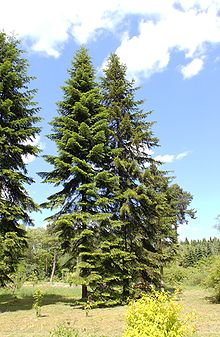Abies sibirica
| Abies sibirica Siberian fir | |
|---|---|

| |
| Scientific classification | |
| Kingdom: | Plantae |
| Clade: | Tracheophytes |
| Clade: | Gymnospermae |
| Division: | Pinophyta |
| Class: | Pinopsida |
| Order: | Pinales |
| Family: | Pinaceae |
| Genus: | Abies |
| Species: | A. sibirica
|
| Binomial name | |
| Abies sibirica | |
Abies sibirica, the Siberian fir, is a
Distribution
The tree lives in the cold boreal climate on moist soils in mountains or river basins at elevations of 1900–2400 m. It is very shade-tolerant, frost-resistant, and hardy, surviving temperatures down to −50 °C. It rarely lives over 200 years due to the susceptibility to fungal decay in the wood.
Description
Siberian fir, Abies sibirica, grows 30–35 m tall with a trunk diameter of 0.5–1 m at breast height and a conical crown. The bark is grey-green to grey-brown and smooth with resin blisters typical of most firs. Shoots are yellow-grey, resinous, and slightly pubescent. The leaves are needle-like, 2–3 cm long and 1.5 mm broad on average. They are light green above with two grey-white stomatal bands underneath, and are directed upwards along the stem. They are soft, flattened, and strongly aromatic. The cones are cylindrical, 5–9.5 cm long and 2.5–3.5 cm broad, with small bracts hidden by the scales. They ripen from bluish to brown or dark brown in mid-autumn. The seeds, 7 mm long with a triangular wing 0.7–1.3 cm long, are released when the cone disintegrates after maturity.
Varieties
There are two
- Abies sibirica var. sibirica. Described above.
- Abies sibirica var. semenovii (B. Fedtschenko) Farjon. Endemic in Kyrgyzstan. Branchlets noticeably ridged and grooved. Resin canals marginal. Cones yellow-brown, with broader bracts than those of var. sibirica.
Ecology
Abies sibirica is subject to infection from the fungus Delphinella balsameae which was reported from Russia for the first time in 2003.[2]
Uses
References
- . Retrieved 10 January 2018.
- ISSN 0026-3648.

